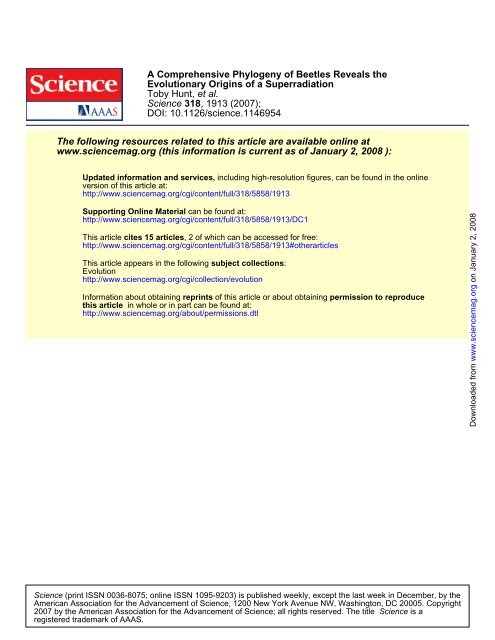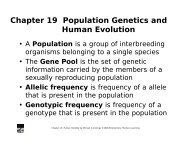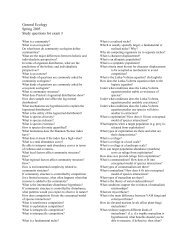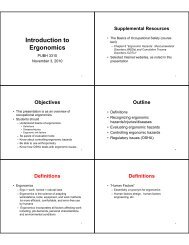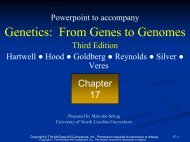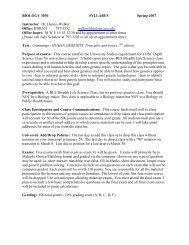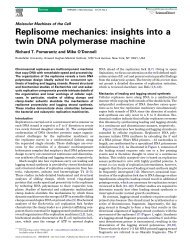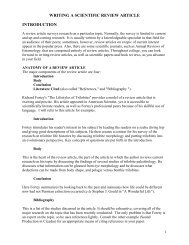Hunt et al. 2007
Hunt et al. 2007
Hunt et al. 2007
You also want an ePaper? Increase the reach of your titles
YUMPU automatically turns print PDFs into web optimized ePapers that Google loves.
A Comprehensive Phylogeny of Be<strong>et</strong>les Reve<strong>al</strong>s the<br />
Evolutionary Origins of a Superradiation<br />
Toby <strong>Hunt</strong>, <strong>et</strong> <strong>al</strong>.<br />
Science 318, 1913 (<strong>2007</strong>);<br />
DOI: 10.1126/science.1146954<br />
The following resources related to this article are available online at<br />
www.sciencemag.org (this information is current as of January 2, 2008 ):<br />
Updated information and services, including high-resolution figures, can be found in the online<br />
version of this article at:<br />
http://www.sciencemag.org/cgi/content/full/318/5858/1913<br />
Supporting Online Materi<strong>al</strong> can be found at:<br />
http://www.sciencemag.org/cgi/content/full/318/5858/1913/DC1<br />
This article cites 15 articles, 2 of which can be accessed for free:<br />
http://www.sciencemag.org/cgi/content/full/318/5858/1913#otherarticles<br />
This article appears in the following subject collections:<br />
Evolution<br />
http://www.sciencemag.org/cgi/collection/evolution<br />
Information about obtaining reprints of this article or about obtaining permission to reproduce<br />
this article in whole or in part can be found at:<br />
http://www.sciencemag.org/about/permissions.dtl<br />
Downloaded from www.sciencemag.org on January 2, 2008<br />
Science (print ISSN 0036-8075; online ISSN 1095-9203) is published weekly, except the last week in December, by the<br />
American Association for the Advancement of Science, 1200 New York Avenue NW, Washington, DC 20005. Copyright<br />
<strong>2007</strong> by the American Association for the Advancement of Science; <strong>al</strong>l rights reserved. The title Science is a<br />
registered trademark of AAAS.
17. J. M. Warren, G. Hirth, Earth Plan<strong>et</strong>. Sci. L<strong>et</strong>t. 248, 438<br />
(2006).<br />
18. T. V. Gerya, B. Stoeckhert, A. Perchuk, Tectonics 21, 1056<br />
(2002).<br />
19. C. Subarya <strong>et</strong> <strong>al</strong>., Nature 440, 46 (2006).<br />
20. N. I. Christensen, Int. Geol. Rev. 46, 795 (2004).<br />
21. T. Seno, Earth Plan<strong>et</strong>. Sci. L<strong>et</strong>t. 231, 249 (2005).<br />
22. M. Simoes, J. P. Avouac, R. Cattin, P. Henry, J. Geophys.<br />
Res. Solid Earth 109, B10402 (2004).<br />
23. D. L. Turcotte, G. Schubert, Geodynamics (Cambridge<br />
Univ. Press, ed. 2, 2002).<br />
24. S. Ide, G. C. Beroza, D. R. Shelly, T. Uchide, Nature 447,<br />
76 (<strong>2007</strong>).<br />
25. A. M. Freed, R. Burgmann, Nature 430, 548 (2004).<br />
26. H. Ueda, M. Ohtake, H. Sato, J. Geophys. Res. Solid Earth<br />
108, 2151 (2003).<br />
27. K. Regenauer-Lieb, D. A. Yuen, J. Branlund, Science 294,<br />
578 (2001).<br />
28. J. A. Conder, Phys. Earth Plan<strong>et</strong>. Int. 149, 155 (2005).<br />
29. P. Raterron, Y. Wu, D. J. Weidner, J. Chen, Phys. Earth<br />
Plan<strong>et</strong>. Int. 145, 149 (2004).<br />
30. S. Karato, D. C. Rubie, H. Yan, J. Geophys. Res. Solid<br />
Earth 98, 9761 (1993).<br />
31. A. Dimanov, G. Dresen, J. Geophys. Res. Solid Earth 110,<br />
B07203 (2005).<br />
32. We thank B. Van de Moortèle for the electron microscopy<br />
and J. Blichert-Toft, F. Albarède, J. Bass, and the two<br />
anonymous reviewers for their suggestions. This work was<br />
supported by the Institut Nation<strong>al</strong> des Sciences de<br />
l’Univers (SEDIT program). The experiment was carried<br />
out at GeoSoilEnviroCARS (Sector 13) at the Advanced<br />
Photon Source (APS), Argonne Nation<strong>al</strong> Laboratory. Use<br />
of the APS was supported by the U.S. Department of<br />
Energy (DOE), Office of Science, Office of Basic Energy<br />
Sciences, under contract no. DE-AC02-06CH11357.<br />
GeoSoilEnviroCARS is supported by NSF–Earth Sciences<br />
(grant EAR-0217473), DOE-Geosciences (grant DE-FG02-<br />
94ER14466), and the State of Illinois.<br />
Supporting Online Materi<strong>al</strong><br />
www.sciencemag.org/cgi/content/full/318/5858/1910/DC1<br />
Materi<strong>al</strong>s and M<strong>et</strong>hods<br />
Figs. S1 to S8<br />
Tables S1 to S3<br />
References<br />
30 July <strong>2007</strong>; accepted 7 November <strong>2007</strong><br />
10.1126/science.1148494<br />
REPORTS<br />
A Comprehensive Phylogeny of<br />
Be<strong>et</strong>les Reve<strong>al</strong>s the Evolutionary<br />
Origins of a Superradiation<br />
Toby <strong>Hunt</strong>, 1,2 * Johannes Bergsten, 1,2 * Zuzana Levkanicova, 3 Anna Papadopoulou, 1,2<br />
Oliver St. John, 1,2 Ruth Wild, 1,2 P<strong>et</strong>er M. Hammond, 1 Dirk Ahrens, 4 Michael B<strong>al</strong>ke, 1,4<br />
Michael S. Caterino, 1,5 Jesús Gómez-Zurita, 1,6 Ignacio Ribera, 7 Timothy G. Barraclough, 2<br />
Milada Bocakova, 8 Ladislav Bocak, 3 Alfried P. Vogler 1,2 †<br />
Be<strong>et</strong>les represent <strong>al</strong>most one-fourth of <strong>al</strong>l described species, and knowledge about their<br />
relationships and evolution adds to our understanding of biodiversity. We performed a<br />
comprehensive phylogen<strong>et</strong>ic an<strong>al</strong>ysis of Coleoptera inferred from three genes and nearly 1900<br />
species, representing more than 80% of the world’s recognized be<strong>et</strong>le families. We defined<br />
bas<strong>al</strong> relationships in the Polyphaga supergroup, which contains over 300,000 species, and<br />
established five families as the earliest branching lineages. By dating the phylogeny, we found that<br />
the success of be<strong>et</strong>les is explained neither by exception<strong>al</strong> n<strong>et</strong> diversification rates nor by a<br />
predominant role of herbivory and the Cr<strong>et</strong>aceous rise of angiosperms. Instead, the pre-Cr<strong>et</strong>aceous<br />
origin of more than 100 present-day lineages suggests that be<strong>et</strong>le species richness is due to<br />
high surviv<strong>al</strong> of lineages and sustained diversification in a vari<strong>et</strong>y of niches.<br />
The extraordinary diversity of be<strong>et</strong>les has<br />
long fascinated evolutionary biologists<br />
(1). The strongly sclerotized front wings<br />
defining the order Coleoptera (the be<strong>et</strong>les), which<br />
provide protection while r<strong>et</strong>aining the ability of<br />
powered flight with the membranous hindwings,<br />
may be an evolutionary novelty that promoted<br />
extensive diversification (2). Be<strong>et</strong>les appeared<br />
around 285 million years ago (Ma) (2, 3), followed<br />
by radiations of wood-boring (suborder<br />
1 Department of Entomology, Natur<strong>al</strong> History Museum, Cromwell<br />
Road, London SW7 5BD, UK. 2 Department of Biology,<br />
Imperi<strong>al</strong> College London, Silwood Park Campus, Ascot SL5<br />
7PY, UK. 3 Department of Zoology, Faculty of Science, P<strong>al</strong>acky<br />
University, tr. Svobody 26, 77146 Olomouc, Czech Republic.<br />
4 Zoologische Staatssammlung München, Münchhausenstrasse<br />
21, 81247 München, Germany. 5 Santa Barbara Museum of<br />
Natur<strong>al</strong> History, 2559 Puesta del Sol Road, Santa Barbara, CA<br />
93105–2998, USA. 6 Fisiologia i Biodiversitat Molecular, IBMB-<br />
CSIC, Jordi Girona 18-26, 08034 Barcelona, Spain. 7 Departamento<br />
de Biodiversidad y Biología Evolutiva, Museo Nacion<strong>al</strong><br />
de Ciencias Natur<strong>al</strong>es, José Gutiérrez Abasc<strong>al</strong> 2, 28006 Madrid,<br />
Spain. 8 Department of Biology, Pedagogic<strong>al</strong> Faculty, P<strong>al</strong>acky<br />
University, Purkrabska 2, 77140 Olomouc, Czech Republic.<br />
*These authors contributed equ<strong>al</strong>ly to the work.<br />
†To whom correspondence should be addressed. E-mail:<br />
a.vogler@imperi<strong>al</strong>.ac.uk<br />
Archostemata), predacious (Adephaga), and fungivorous<br />
(Polyphaga) lineages (4) present in the<br />
fossil record from the middle Triassic on (2, 3).<br />
Their species richness is associated with extreme<br />
morphologic<strong>al</strong>, ecologic<strong>al</strong>, and behavior<strong>al</strong> diversity<br />
(4), and diversification of the most speciesrich<br />
extant lineages may have been driven by<br />
co-radiations with angiosperms (5) and/ormamm<strong>al</strong>s<br />
(6) and/or geologic<strong>al</strong> and climatic change (7)<br />
occurring since the Cr<strong>et</strong>aceous (145 to 65 Ma).<br />
Studies of phylogen<strong>et</strong>ic relationships within<br />
the Coleoptera resulted in a preliminary consensus<br />
on the classification, defining 4 suborders, 17<br />
superfamilies, and 168 families (8–10). However,<br />
form<strong>al</strong> phylogen<strong>et</strong>ic an<strong>al</strong>yses of morphologic<strong>al</strong><br />
characters (11, 12) and more recently molecular<br />
data (5, 13, 14) have been limited to subgroups at<br />
the family or superfamily level. Because of the<br />
sheer size of the group and the complexity of<br />
morphologic<strong>al</strong> character systems, these an<strong>al</strong>yses<br />
have not been applied to the entire order.<br />
We compiled a three gene data matrix providing<br />
a compl<strong>et</strong>e taxonomic representation for<br />
<strong>al</strong>l suborders, series and superfamilies; >80% of<br />
recognized families; and >60% of subfamilies<br />
(9, 10), which tog<strong>et</strong>her contain >95% of described<br />
be<strong>et</strong>le species. Sequences for the sm<strong>al</strong>l subunit<br />
ribosom<strong>al</strong> RNA (18 S rRNA) were obtained for<br />
1880 species from de novo sequencing and<br />
existing databases. Mitochondri<strong>al</strong> 16S rRNA<br />
(rrnL) and cytochrome oxidase subunit I (cox1)<br />
sequences were added for nearly h<strong>al</strong>f of these taxa<br />
(table S1) to create a data matrix of rapid, medium,<br />
and slowly evolving sequences. Phylogen<strong>et</strong>ic<br />
an<strong>al</strong>ysis of the combined matrix was performed<br />
with a fragment-extension procedure for glob<strong>al</strong><br />
sequence <strong>al</strong>ignment followed by tree searches<br />
with fast parsimony <strong>al</strong>gorithms (15). We tested for<br />
long-branch attraction, i.e., the spurious pairing of<br />
rapidly evolving lineages, by removing taxa termin<strong>al</strong><br />
to long branches and assessing trees with a<br />
r<strong>et</strong>ention index (RI) measure of fit to the tradition<strong>al</strong><br />
classification (table S2) (15). The resulting parsimony<br />
tree largely agrees with the existing classification<br />
at the family and superfamily levels [on<br />
average, 95.7% of termin<strong>al</strong>s assigned to a family<br />
were recovered as monophyla (table S2)], <strong>al</strong>though<br />
our taxon sampling was not comprehensive<br />
in some families. Model-based Bayesian<br />
m<strong>et</strong>hods were applied to a 340-taxon representative<br />
subs<strong>et</strong> at the subfamily level.<br />
The trees (Figs. 1 and 2) were rooted with the<br />
neuropterid orders, the presumed sister to the<br />
Coleoptera (16), and recovered the major subdivisions<br />
of Adephaga [37,000 known species;<br />
posterior probability (pp) = 1.0] and Polyphaga<br />
(>300,000 species; pp =1.0)assisterstothe<br />
Myxophaga (94 species) plus Archostemata (40<br />
species) (8). The Adephaga was divided into two<br />
clades containing an aquatic (Hydradephaga;<br />
diving be<strong>et</strong>les and whirligig be<strong>et</strong>les; pp =0.90)<br />
and a terrestri<strong>al</strong> (Geadephaga; ground be<strong>et</strong>les and<br />
tiger be<strong>et</strong>les; pp = 1.0) lineage, supporting a<br />
single terrestri<strong>al</strong>-to-aquatic transition in this suborder<br />
(13).<br />
In the strongly supported suborder Polyphaga,<br />
five families occupied the bas<strong>al</strong> nodes (Figs.<br />
1and2)(pp = 1.0). These families include the<br />
Decliniidae; the Scirtidae, with aquatic larvae;<br />
the Derodontidae, an ecologic<strong>al</strong>ly diverse family<br />
from glob<strong>al</strong> temperate zones; and the Eucin<strong>et</strong>idae<br />
and the Clambidae. These ancestr<strong>al</strong> five families<br />
were previously considered bas<strong>al</strong> Elateriformia<br />
(superfamily Scirtoidea), except for Derodontidae,<br />
Downloaded from www.sciencemag.org on January 2, 2008<br />
www.sciencemag.org SCIENCE VOL 318 21 DECEMBER <strong>2007</strong> 1913
REPORTS<br />
which has been associated with Bostrichiformia<br />
(9, 10). All five families exhibit archaic morphologic<strong>al</strong><br />
features shared only with Archostemata<br />
and Adephaga (8, 17). Their bas<strong>al</strong> position was<br />
stable (<strong>al</strong>ways pp = 1.0) (table S3) when trees<br />
were rooted with the neuropterid orders or only<br />
with Myxophaga or Adephaga as outgroups.<br />
All superfamilies of Polyphaga were previously<br />
grouped into five series (4, 9), of which<br />
only the Scarabaeiformia ( pp =1.0)andthe<br />
Cucujiformia ( pp = 1.0) were strongly supported<br />
as monophyl<strong>et</strong>ic in this study. Staphyliniformia<br />
comprised a paraphyl<strong>et</strong>ic bas<strong>al</strong> grade, and both<br />
Bostrichiformia and Elateriformia were polyphyl<strong>et</strong>ic.<br />
Relationships among the five series were<br />
poorly supported or unresolved in the consensus<br />
tree (fig. S1). Nosodendridae, usu<strong>al</strong>ly included in<br />
Bostrichiformia near Derodontidae (4, 9) butrecently<br />
associated with Scirtoidea on the basis of<br />
thoracic characters (18), grouped instead with the<br />
nonscirtoid Elateriformia, <strong>al</strong>beit with low support<br />
(fig. S1) ( pp = 0.59).<br />
Within Elateriformia, the superfamilies Buprestoidea<br />
( jewel be<strong>et</strong>les; pp = 1.0), Dascilloidea<br />
( pp = 1.0), and Elateroidea (click be<strong>et</strong>les and<br />
<strong>al</strong>lies; pp = 0.72) were supported. Our data<br />
showed that Byrrhoidea, sensu Lawrence and<br />
Newton (9), is paraphyl<strong>et</strong>ic, supporting the division<br />
of this clade (8) into Byrrhoidea (Byrrhidae,<br />
moss be<strong>et</strong>les; pp = 1.0) and Dryopoidea (riffle<br />
be<strong>et</strong>les and water pennies). The Cantharoidea<br />
(soldier be<strong>et</strong>les, fireflies, <strong>et</strong>c.) fell inside the<br />
Elateroidea, and our tree supported that bioluminescence<br />
arose repeatedly in be<strong>et</strong>les, in agreement<br />
with structur<strong>al</strong> differences in luciferases<br />
(19). Scarabaeiformia (chafers, stag be<strong>et</strong>les, and<br />
dung be<strong>et</strong>les; pp = 1.0) is thought to be related to<br />
the Staphyliniformia (4, 14, 20). In our trees, it<br />
was part of an unresolved paraphyl<strong>et</strong>ic Staphyliniformia<br />
including the superfamilies Histeroidea<br />
(clown be<strong>et</strong>les; pp = 1.0); Hydrophiloidea<br />
( pp = 1.0), a clade of both Leiodidae and Agyrtidae<br />
( pp = 1.0); the Staphylinidae (rove be<strong>et</strong>les including<br />
Silphidae and carrion be<strong>et</strong>les; pp = 0.86);<br />
and the Hydraenidae as sister ( pp = 0.74) to the<br />
Ptiliidae (featherwing be<strong>et</strong>les).<br />
The hyperdiverse Cucujiformia, representing<br />
more than h<strong>al</strong>f of <strong>al</strong>l be<strong>et</strong>les and 90 families, was<br />
strongly supported as monophyl<strong>et</strong>ic (Figs. 1 and<br />
2; pp = 1.0). Among the seven established superfamilies,<br />
the Lymexyloidea (ship-timber be<strong>et</strong>les)<br />
was found near the base of the Tenebrionoidea<br />
(30 families; pp = 0.76). The Cleroidea (checkered<br />
be<strong>et</strong>les and <strong>al</strong>lies) was monophyl<strong>et</strong>ic ( pp = 0.70)<br />
only when including the Biphyllidae plus Byturidae<br />
( pp = 1.0). The latter two were formerly<br />
classified as Cucujoidea, but their association with<br />
Cleroidea is supported by genit<strong>al</strong>ic characters<br />
(11). The Cucujoidea, comprising 34 families,<br />
was polyphyl<strong>et</strong>ic, but the Cerylonid series (Figs.<br />
1 and 2 and fig. S3) ( pp = 1.0) consisting of eight<br />
families (21) was monophyl<strong>et</strong>ic. Apart from the<br />
Sphindidae ( pp = 1.0), the remaining cucujoid<br />
families formed a monophyl<strong>et</strong>ic clade ( pp =0.72)<br />
tog<strong>et</strong>her with the species-rich Curculionoidea<br />
Fig. 1. One of 27 most parsimonious<br />
trees obtained from the<br />
<strong>al</strong>igned 1880-taxon matrix. The<br />
number of representatives from<br />
each major lineage an<strong>al</strong>yzed (in<br />
colors) is given. Major clades are<br />
denoted by l<strong>et</strong>ters: A, Adephaga;<br />
B, Polyphaga; C, Polyphaga minus<br />
the ancestr<strong>al</strong> five families;<br />
and D, Cucujiformia. For full d<strong>et</strong>ails<br />
of the tree, see fig. S4.<br />
(weevils and bark be<strong>et</strong>les; pp = 0.73) and<br />
Chrysomeloidea (leaf be<strong>et</strong>les and longhorns).<br />
Once the relationships among coleopteran<br />
families and superfamilies were established, we<br />
investigated the origins of be<strong>et</strong>le diversity. Diversification<br />
may be driven by feeding strategy, and<br />
we tested the hypothesis that feeding on plants<br />
(herbivory), and specific<strong>al</strong>ly flowering plants (angiosperms),<br />
explains the diversity of be<strong>et</strong>les (5). Predominantly<br />
herbivorous clades tend to contain<br />
Table 1. Comparisons of species richness b<strong>et</strong>ween clades feeding on living plants and their sister clades<br />
with <strong>al</strong>ternative feeding strategies. Restricting the comparisons to those feeding on angiosperms removes<br />
contrast 4 and adds two contrasts of angiosperm- versus gymnosperm-feeding lineages within Curculionoidea<br />
and two within Chrysomeloidea [table S4; see <strong>al</strong>so (5)]. Plant-feeding clades include taxa feeding<br />
mainly on rotting veg<strong>et</strong>ation in contrast 7 or in recently dead wood in contrast 8, but probably >70% of<br />
species in both clades are herbivorous. Excluding the last two contrasts increases the probability under a<br />
Wilcoxon test to P =0.28.<br />
Plant-feeding<br />
Di<strong>et</strong><br />
No. of<br />
species<br />
Non–plantfeeding<br />
Di<strong>et</strong><br />
No. of<br />
species<br />
1 Byturidae Fruits, flowers 16 Biphyllidae Fungivorous 195<br />
2 Languriinae Stem borers 800 Xenoscelinae Fungivorous, 100<br />
decaying<br />
veg<strong>et</strong>ation<br />
3 Chrysomeloidea Herbivorous<br />
xylophagous<br />
53,442 Nitidulidae plus<br />
Erotylid plus<br />
Cucujid series<br />
Mostly<br />
fungivorous<br />
7743<br />
4 Curculionoidea Herbivorous<br />
xylophagous<br />
59,340 Brontinae plus<br />
Silvaninae plus<br />
Priasilphinae<br />
Fungivorous 480<br />
5 Epilachninae Herbivorous 1051 Coccidulinae Predacious 3900<br />
plus<br />
Chilocorinae<br />
plus Scymninae<br />
6 Dascillinae Roots 80 Rhipiceridae Ectoparasitic on<br />
cicadas<br />
57<br />
7 Melolonthinae<br />
plus Orphninae<br />
plus Rutelinae<br />
plus Dynastinae<br />
Herbivorous (and<br />
saprophagous)<br />
8 Buprestidae Xylophagous,<br />
herbivorous,<br />
roots, leaf<br />
miners<br />
16,329 C<strong>et</strong>oniinae Saprophagous<br />
(d<strong>et</strong>ritus)<br />
14,000 Dryopoidea Saprophagous,<br />
<strong>al</strong>givorous<br />
4121<br />
3242<br />
Downloaded from www.sciencemag.org on January 2, 2008<br />
1914<br />
21 DECEMBER <strong>2007</strong> VOL 318 SCIENCE www.sciencemag.org
more species than nonherbivorous sister clades,<br />
but this difference was not significant [Table 1;<br />
one-tailed Wilcoxon test on contrasts in log (no.<br />
of species), P = 0.13] even when we distinguished<br />
b<strong>et</strong>ween angiosperm and gymnosperm feeders<br />
(P = 0.06) (table S4). Similarly, of 21 significant<br />
REPORTS<br />
shifts in diversification rate inferred with a robust<br />
equ<strong>al</strong> rates null model (22, 23), only two characterize<br />
transitions b<strong>et</strong>ween angiosperm and gymno-<br />
Downloaded from www.sciencemag.org on January 2, 2008<br />
Fig. 2. The phylogeny of Coleoptera at the subfamily level. The tree was<br />
selected from the 340-taxon Bayesian an<strong>al</strong>ysis based on maximum congruence<br />
with the majority-rule consensus (fig. S1). Posterior probability clade<br />
support v<strong>al</strong>ues indicated at nodes >0.5. Approximate known species<br />
numbers in termin<strong>al</strong> taxa are given in parentheses. Black circles mark<br />
significant shifts in diversification rate of sister clades (table S5). Colored<br />
triangles mark character transitions in lifestyles inferred by parsimony<br />
optimization (see figs. S2 and S3 for d<strong>et</strong>ails).<br />
www.sciencemag.org SCIENCE VOL 318 21 DECEMBER <strong>2007</strong> 1915
REPORTS<br />
sperm feeders, whereas the remainder showed no<br />
association with transitions to feeding on angiosperms<br />
or seed plants (table S5). A significant increase<br />
in diversification rate was inferred near the<br />
base of the Polyphaga wh<strong>et</strong>her herbivorous taxa<br />
were included or excluded from the an<strong>al</strong>yses (table<br />
S5). Herbivory has played a role in the diversification<br />
of some be<strong>et</strong>le lineages, but the trait per<br />
se does not explain why be<strong>et</strong>les are so diverse.<br />
Fast diversification rates <strong>al</strong>so do not explain<br />
be<strong>et</strong>le diversity. Dating the tree with fossil c<strong>al</strong>ibration<br />
and pen<strong>al</strong>ized likelihood rate-smoothing<br />
(Fig. 3 and table S6) (15), we estimated n<strong>et</strong> diversification<br />
rates across termin<strong>al</strong> taxa of 0.048 to<br />
0.068 Myear −1 (table S7), slightly lower than<br />
comparable measures for the angiosperms (0.077<br />
Myear −1 )(24). However, more than 100 modern<br />
Fig. 3. A dated 340-<br />
taxon “<strong>al</strong>l-compatible”<br />
consensus tree of Coleoptera<br />
from Bayesian<br />
an<strong>al</strong>ysis was dated with<br />
pen<strong>al</strong>ized likelihood placing<br />
the origin of Coleoptera<br />
at 285 Ma (15).<br />
Estimated number of<br />
lineages present at 200<br />
Ma, 36; at 140 Ma, 145;<br />
and at 65 Ma, 301 (see<br />
<strong>al</strong>so table S7). Colors<br />
correspond to the same<br />
groups as in Fig. 1. Numbers<br />
refer to average ages<br />
and 95% confidence<br />
interv<strong>al</strong>s (15) ofselected<br />
clades (open circles): CER,<br />
Cerylonid series; CUC,<br />
Cucujiformia; NIT, Nitidulidae;<br />
CUR, Curculionoidea;<br />
ELT, Elateroidea;<br />
ELA, Elateriformia; BOS,<br />
Bostrichiformia; HYP, Hydrophiloidea;<br />
HIS, Histeroidea;<br />
POL, Polyphaga;<br />
HYD, Hydradephaga; ADE,<br />
Adephaga; and M&A, Myxophaga<br />
and Archostemata.<br />
Seven fossil c<strong>al</strong>ibration<br />
points (table S6) were used<br />
to cross-v<strong>al</strong>idate ratesmoothing<br />
param<strong>et</strong>ers (optim<strong>al</strong><br />
v<strong>al</strong>ue = 100) (15):<br />
point a, Cupedidae; b,<br />
Sogdodromeus (Geadephaga);<br />
c, Staphylinidae;<br />
d, Holcorobeus (Scarabaeoidea);<br />
e, Elaterophanes<br />
(Elateridae); f,<br />
Cerambycomima (Chrysomeloidea);<br />
and g, Praemordella<br />
(Mordellidae).<br />
be<strong>et</strong>le lineages were present at the first appearance<br />
of crown-group angiosperms dated to


